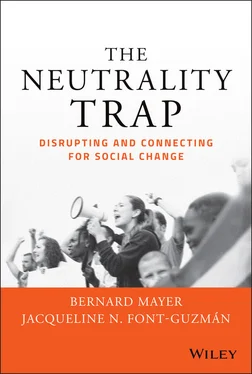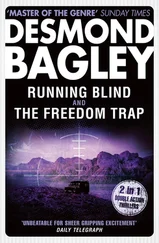Bernard S. Mayer - The Neutrality Trap
Здесь есть возможность читать онлайн «Bernard S. Mayer - The Neutrality Trap» — ознакомительный отрывок электронной книги совершенно бесплатно, а после прочтения отрывка купить полную версию. В некоторых случаях можно слушать аудио, скачать через торрент в формате fb2 и присутствует краткое содержание. Жанр: unrecognised, на английском языке. Описание произведения, (предисловие) а так же отзывы посетителей доступны на портале библиотеки ЛибКат.
- Название:The Neutrality Trap
- Автор:
- Жанр:
- Год:неизвестен
- ISBN:нет данных
- Рейтинг книги:3 / 5. Голосов: 1
-
Избранное:Добавить в избранное
- Отзывы:
-
Ваша оценка:
- 60
- 1
- 2
- 3
- 4
- 5
The Neutrality Trap: краткое содержание, описание и аннотация
Предлагаем к чтению аннотацию, описание, краткое содержание или предисловие (зависит от того, что написал сам автор книги «The Neutrality Trap»). Если вы не нашли необходимую информацию о книге — напишите в комментариях, мы постараемся отыскать её.
The Neutrality Trap,
The Neutrality Trap
The Neutrality Trap — читать онлайн ознакомительный отрывок
Ниже представлен текст книги, разбитый по страницам. Система сохранения места последней прочитанной страницы, позволяет с удобством читать онлайн бесплатно книгу «The Neutrality Trap», без необходимости каждый раз заново искать на чём Вы остановились. Поставьте закладку, и сможете в любой момент перейти на страницу, на которой закончили чтение.
Интервал:
Закладка:
Who was being protected? The aggressor? The other White students? The teacher? The school? The system? It's clear who was not being protected—a 9‐year‐old Black student who, along with so many others, experiences racism every day. This incident took place in Canada, but it could have happened anywhere. Racism is entrenched throughout our system, as is misogyny, gender‐based discrimination, xenophobia, and predatory capitalism. Our response as a society to these problems has by and large been too little, too slow, and too performative. If we don't blame the victims (which we often do), we focus on individual perpetrators, not on the systemic problems. We look for quick, facile solutions, a nice and neat end to the “conflict,” so that we can move on as quickly as possible.
Our Purpose
In this book, we look at what it takes for a system to change in meaningful ways—what is required to dig deeply enough and act decisively enough to make a genuine difference on the most embedded, serious problems we face. We do so by looking at the lessons we have learned at the intersection of our work as conflict interveners and social activists. In both roles, we have dealt with intractable conflicts and systemic problems. In both, we have worked at the intersection of individual actions, interpersonal relationships, and enduring conflicts that have been with us for years, even centuries. These problems will not simply disappear by reaching an agreement or enacting a new policy. As important as improved relationships, resolved conflicts, and good policies are, they are not the same as changing systems embedded in values, identity, power, and privilege.
We argue in this book that by promoting connections across our differences, conflict intervention efforts can play an important role in social change. Approaches such as dialogue, facilitated interactions, and restorative justice can be an integral part of struggles against oppression but only if they are in sync with concerted efforts at system disruption. Dialogue for the sake of dialogue and collaboration for the sake of collaboration, disconnected from a commitment to social change, is likely to reinforce the status quo . This is the neutrality trap . Unless our engagement efforts are matched by an equally strong commitment to disrupting oppressive systems, they will fail to make a profound contribution to social change. By trying to remain objective, neutral, impartial, and separate, conflict interveners and academics (along with many other professionals) reinforce system‐maintaining norms, narratives, and practices that perpetuate a status quo that is calling out for change.
Disruption too is just part of the process of change. Effective social movements need to develop their capacity to participate in constructive engagement efforts as they continue to challenge the power structures that maintain systems of oppression. When and how to connect across our differences is an ongoing challenge because the energy and tactics necessary to disrupt systems can be at odds with the requirements for effective dialogue. How activists manage the tension between these two elements of the change process is a defining feature of how movements evolve and the success or failure of their efforts. Exploring how to navigate this practical challenge is a central theme of this book.
Another dynamic tension that social movements must be sensitive to is the difference between what we refer to as chaotic disruption and strategic disruption. Chaotic disruption —for example, when mass protests erupted after George Floyd's murder, the spontaneous demonstrations that led to the “Arab Spring,” and the Stonewall riots in 1969—are essential to social change efforts because they mobilize support, attract a great deal of attention, and force reactions from those in power. But chaotic disruption is hard to sustain and difficult to keep clearly focused on the systemic nature of the problems they confront. Strategic disruption —for example, the ongoing actions of the civil rights, anti‐nuclear, and environmental movements—keep the pressure on for systems change over time. They can go hand in hand with the building of sustainable organizational structures necessary for long‐term efforts. But without the potential for chaotic disruption from time to time, their power is more easily circumscribed and even neutralized.
We explore these dynamics by looking at a wide range of both successful and faltering social change efforts, the analyses of activists and scholars, and our own experiences as conflict interveners and activists. We also discuss examples from the institutions and communities we belong to. Most of the stories we share are from public actions and interventions that we have been part of. Where we have discussed confidential matters, we have omitted or changed identifying information. We believe that these efforts, whether or not part of an organized movement, all have a role to play in promoting social change.
Our Perspectives
Of particular importance to us are the concepts and strategies that appear relevant to both the conflict engagement and the social change efforts we have been part of. We were determined not to fall into the neutrality trap. We believe that raising difficult issues and escalating conflict is necessary to understand our world and to bring about change. We do not hesitate to share our points of view, our values, and our commitments throughout this book. We think this increases the authenticity and value of what we have to say, but we also recognize that for some, this openness about our beliefs may call into question our credibility. We don't agree with that but appreciate that this will be easier to read for those already committed to anti‐racist, anti‐colonialist, pro‐environment, and pro‐egalitarian points of view. We hope others will find it stimulating and valuable as well.
Our thinking about these issues has developed over many years and is reflected in our previous writing. Bernie wrote Beyond Neutrality in 2004 to discuss the limits that conflict professionals place on their capacity to deal with the most important conflicts we face in our families, workplaces, communities, and society. These limits, he argued, stemmed from their focus on the role of the “neutral” and the goal of resolution. He expanded on this theme in Staying with Conflict, where he looked at the enduring nature of our most important conflicts, and in The Conflict Paradox . Bernie came to conflict work with a long background in the civil rights, anti‐war, and environmental movements and as a labor union activist. His views have been informed by his background as a social worker, psychotherapist, and child of Holocaust survivors.
Jackie has long been concerned about racism, colonialism, and misogyny. In her book Experiencing Puerto Rican Citizenship and Cultural Nationalism , she discusses how Puerto Ricans experience and resist colonialism as they forge their national identity at the margin of the United States. Jackie has also written about how structures of oppression operate in the healthcare system and ways to create counter‐narratives to transform (or dismantle) institutional and structural injustices. Jackie came to conflict work with a strong background as a healthcare administrator and a lawyer focusing on employment discrimination, civil rights, family law, and healthcare law. Her views have also been shaped by her experiences of being raised in Puerto Rico—a US colony—and countless conversations at the dinner table with her mother, who was a psychiatrist.
In all our work as professionals, trainers, teachers, and scholars, we have both been committed to being reflective practitioners. Our ideas are informed by our studies but are nurtured and tested in the cauldron of our practice experience, both as activists and interveners. This book is part of that conversation and will hopefully help others examine their own thinking, experiences, and practice in response.
Читать дальшеИнтервал:
Закладка:
Похожие книги на «The Neutrality Trap»
Представляем Вашему вниманию похожие книги на «The Neutrality Trap» списком для выбора. Мы отобрали схожую по названию и смыслу литературу в надежде предоставить читателям больше вариантов отыскать новые, интересные, ещё непрочитанные произведения.
Обсуждение, отзывы о книге «The Neutrality Trap» и просто собственные мнения читателей. Оставьте ваши комментарии, напишите, что Вы думаете о произведении, его смысле или главных героях. Укажите что конкретно понравилось, а что нет, и почему Вы так считаете.












